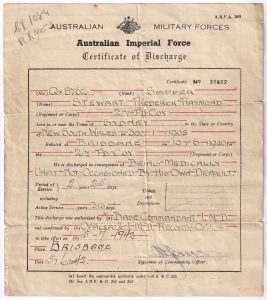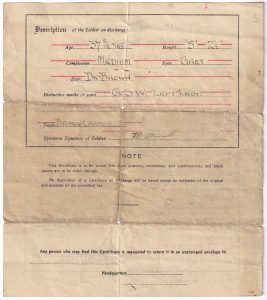[Editor: This Certificate of Discharge, for Frederick Raymond Stewart, is dated 5 June 1942, during the Second World War (1939-1945).]
Certificate of Discharge, for Frederick Raymond Stewart, 1942
[Front of certificate]
[Handwritten and stamped text, in italics]
A.A.F.A. 209
Australian Military Forces
Australian Imperial Force
Certificate of Discharge
Certificate No. 31682
(No.) ….. QX8762 ….. (Rank) ….. Sapper
(Name) ….. Stewart Frederick Raymond
(Regiment or Corps) ….. 2/7 Fd Coy
born in or near the Town of ….. Sydney ….. in the State or Country
of ….. New South Wales ….. on ….. 30 / 1 / 1905
Enlisted at ….. Brisbane ….. on ….. 10 / 6 / 1940 for
the ….. 2/7 Fd. Coy ….. (Regiment or Corps)
He is discharged in consequence of ….. Being Medically Unfit Not Occasioned By His Own Default.
Period of Service } ….. 2 ….. years ….. 25 ….. days.
including
Active Service ………. years ….. 313 ….. days.
Medals and Decorations } ……….
This discharge was authorized by (a) ….. Base Commandant I.M.D.
and confirmed by (a) ….. Officer I/C I.M.D. Records Office.
to take effect on (b) ….. 5 7 1942.
Place ….. Brisbane
Date 5 / 6 / 1942.
Signature of Commanding Officer: ….. [signed]
(a) Insert the appropriate authority under A.M.R. & O. 255.
(b) See A.M.R. & O. 262 and 263.
[Reverse of certificate]
Description of the Soldier on discharge:
Age ….. 37 5/12 Yrs. ….. Height ….. 5′ 2 1/2″
Complexion ….. Medium ….. Eyes ….. Grey
Hair ….. Dk Brown.
Distinctive marks or scars ….. G.S.W. Left Leg.
Trade ….. Bridge Carpenter
Specimen Signature of Soldier ….. [signed]
NOTE
This Certificate is to be issued free from erasures, corrections, and interlineations, and blank spaces are to be ruled through.
No duplication of a Certificate of Discharge will be issued except on surrender of the original and payment of the prescribed fee.
Any person who may find this Certificate is requested to return it in an unstamped envelope to ….. NORTHERN COMMAND
Headquarters ….. BRISBANE
Source:
Original document
Editor’s notes:
Dimensions (approximate): 200 mm. (width), 225 mm. (height).
A.M.R. & O. = Australian Military Regulations and Orders
Dk = an abbreviation of “Dark”
Fd Coy = Field Company
G.S.W. = Gun Shot Wound
I/C = an abbreviation of “In Charge” or “In Charge of” (e.g. “Officer I/C”, officer in charge; “2 I/C”, second in charge)
interlineation = writing which has been inserted within or between writing from an earlier time (such as additions, explanations, or notations added to a pre-existing document or text)
No. = an abbreviation of “Number”
Yrs. = an abbreviation of “Years”


Hello again Ed. Here I am, nitpicking again.
Firstly: on the ‘reverse’ side of this document, towards the bottom, you transcribe “Any person who may find this Certificate is requested to return it in an unstamped envelope to ………… Headquarters ….. ”
I note that a blue/purple-inked stamp had been used to insert the address as being to “NORTHERN COMMAND” (their capitalisation); and after ‘Headquarters’ is similarly stamped “BRISBANE” (again: their capitalisation).
Secondly: now going back to the front of the document, to the very top, I cannot see any transcription of the pencilled-in notations in the top left-hand corner; being: CX 1084
RX 953
It may be that you have an editorial policy not to do so; or it may be an oversight.
Anyway, as always, over to you; and thanks as usual for all of the wonderful work which you are doing with providing these documents and their transcriptions to all.
Regards: Raymond.
Nice work on spotting the stamped text at the end of the document, regarding the Northern Command. I must admit that it was so faint that I didn’t notice it at all.
The pencilled-in notations in the top left-hand corner have been left out, as they appear to have been added later, and are not part of the document per se. Usually they would only be added if they had some sort of key relevance to the item itself (which could be a subjective matter).
Glad you like these recently-added items.
Thanks again for your input (you have picked up on various things that would have passed by unnoticed – much appreciated).